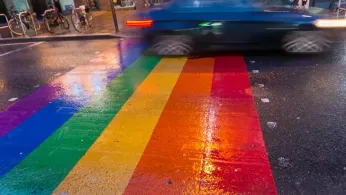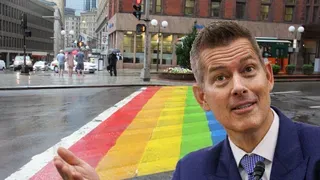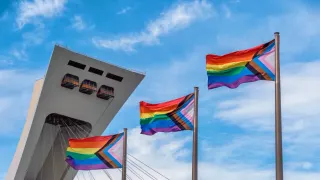
2 hours ago
Queer Advocates Respond to Federal Push Targeting Rainbow Crosswalks
READ TIME: 3 MIN.
On July 1, U.S. Department of Transportation Secretary Sean Duffy announced a sweeping “nationwide roadway safety initiative” aimed at curbing the rising number of traffic fatalities on American roads. In an official letter sent to governors of all 50 states, the District of Columbia, and Puerto Rico, Duffy called for urgent statewide action to address “arterial segments, including intersections, with the highest safety, operations or compliance concerns that will be addressed by the end of Fiscal Year 2026” .
While the broader initiative is intended to address an estimated 39,345 roadway deaths recorded in 2024, much of the ensuing controversy has centered not on the core safety measures but on Duffy’s call for the removal of rainbow-colored crosswalks—crosswalks that have become powerful symbols of LGBTQ+ pride and community visibility in cities across the United States .
Duffy’s directive specifically targets “non-freeway arterial roads”—the network of high-capacity urban roads where the majority of traffic fatalities occur. However, in subsequent remarks and social media posts, Duffy equated rainbow crosswalks with “political banners on public roads,” suggesting they contribute to roadway distraction and, by implication, to roadway deaths .
This framing has drawn swift criticism from LGBTQ+ advocates and transportation experts alike. Multiple studies, including a 2022 Bloomberg analysis, have found that multi-colored “asphalt art”—including rainbow crosswalks—can actually reduce crashes between motorists and vulnerable road users by up to 50 percent on average . Advocates point out that most dangerous arterials have few, if any, crosswalks—rainbow or otherwise—and that the majority of rainbow crosswalks are located on city streets, not arterial roads.
“Removing rainbow crosswalks doesn’t make America’s roads safer. It erases a symbol of LGBTQ+ community pride and inclusion while ignoring proven safety benefits,” said Kea Wilson, writing for Streetsblog USA .
The timing and focus of the directive have led many LGBTQ+ leaders to question whether the move is more political than practical. For years, rainbow crosswalks have served not only as public art but as visible affirmations of LGBTQ+ inclusion, particularly in neighborhoods with a history of discrimination. Local governments and LGBTQ+ organizations have invested in these installations as part of broader initiatives to foster safer, more welcoming communities .
On social media and in public forums, many have expressed concern that the removal of rainbow crosswalks would send a message of exclusion at a time when anti-LGBTQ+ rhetoric is rising in some parts of the country. “Rainbow crosswalks are much more than paint on pavement—they are a visible commitment to equality and safety for all residents,” one LGBTQ+ community leader posted on Instagram (Instagram: @dchomos, https://www.instagram.com/reel/DMl-sfduSRR/, 2025-07-26).
Urban planners and transportation safety experts have also questioned the logic of targeting rainbow crosswalks in a campaign purportedly focused on high-fatality arterials. “Brighter, more colorful crosswalk treatments can improve pedestrian visibility and safety,” said a transportation researcher cited by Planetizen . Many advocates are pushing for rainbow crosswalks to be formally recognized in the Manual on Uniform Traffic Control Devices (MUTCD) due to their potential safety benefits.
Furthermore, the debate has highlighted a gap in the federal approach to road safety. According to Streetsblog USA, many of the most dangerous roads in America lack any form of marked crosswalks—rainbow or otherwise—pointing to a need for broader investment in pedestrian infrastructure rather than the removal of inclusive community symbols .
As states respond to Secretary Duffy’s directive in the coming months, the fate of rainbow crosswalks will remain a flashpoint in the broader conversation about transportation safety and LGBTQ+ inclusion. Advocacy groups are mobilizing to defend the installations, calling for road safety policy that is evidence-based and inclusive of all communities.
The U.S. Department of Transportation has not responded to requests for additional comment on whether rainbow crosswalks will be specifically targeted for removal or whether alternative approaches to intersection safety will be considered. For now, cities and LGBTQ+ advocates across the country are preparing to make the case that visibility and safety need not be mutually exclusive.






